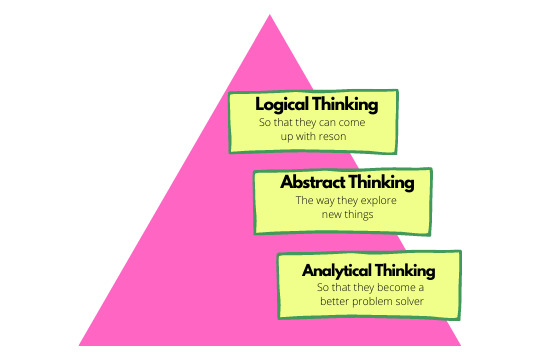Don't wanna be here? Send us removal request.
Text
#scratchprogramming#scratchprogrammingforkids#scratchprogram#programmingscratch#programminginscratch
0 notes
Text
0 notes
Text
0 notes
Text
#scratchprogramming#scratchprogrammingforkids#scratchprogram#programmingscratch#programminginscratch
0 notes
Text

#scratchprogramming#scratchprogrammingforkids#scratchprogram#programmingscratch#programminginscratch
0 notes
Text
#scratchprogramming#scratchprogrammingforkids#scratchprogram#programmingscratch#programminginscratch
0 notes
Text
0 notes
Text
#schooleducation#schoolofeducation#educationschool#schoolandeducation#schoolhealtheducation#educationatschool#preschooleducation
0 notes
Text
0 notes
Text
#codingkids#coding#codingforkids#codingschool#codingclass#codinglife#learncoding#codingislife#stem#codingfun#codingforbeginners#learntocode#kidscoding#stemeducation
0 notes
Text
Does AI require coding
The art of teaching computers to "think" is known as artificial intelligence for children. Students design the "brain" of the computer through coding and programming. Future-oriented artificial intelligence gives students the chance to design cutting-edge technology. In this process, data science is also essential.
He once discovered a problem in IBM's AI software while tinkering with it and reported it on both his personal Twitter account and a programming website. A few technical IBM employees soon noticed and got in touch with him.
Children can study and practice coding to gain first-hand, unique experience with AI technologies.
Kids can learn science, art, and math through creative learning experiences with hundreds of extensions, and they can go on to improve communities in the future. Kids as young as 9 years old can learn about AI and ML (machine learning), interact with the real world, and even create their own AIs with the help of this cutting-edge tool and educational programs
Block-based programming was first developed by the MIT Media Lab. The goal was to create an interface that would let users build computer programs by simply dragging and dropping puzzle pieces to stand in for intricate commands and constructions.
The wildly successful Scratch platform was created as a result of this novel approach to teaching and studying computer science. With this strategy, the bar for experimenting with programmatic thinking was dropped, enabling students to develop interactive animations and minigames without ever writing a line of code.
This straightforward idea makes teaching and studying the fundamentals of computer science accessible to younger students and teachers without a formal coding background by eliminating the requirement to master the syntax of a formal programming language.
Previously, robots that mimic and exhibit "human" cognitive abilities associated with the human mind, like "learning" and "problem-solving," were referred to as "artificial intelligence." Major Artificial Intelligence Courses for Kids researchers have now rejected this notion and are now describing AI in terms of rationality and acting rationally, which does not constrain how intelligence can be expressed.
The first workshop on artificial intelligence was held in 1956 at Dartmouth College. The participants went on to develop and direct the field of AI research. They created programs with their students that the press dubbed "astonishing" because they taught computers how to play checkers, solve algebraic word problems, prove logical theorems, and speak English. By the middle of the 1960s, the Department of Defense had constructed laboratories all over the world and was extensively funding research in the United States.

#artificialintelligence#intelligenceartificial#artificialgeneralintelligence#machinelearning#machineintelligence#learningmachine#machinelearningalgorithms#machinelearningtools
0 notes
Text
#artificialintelligence#intelligenceartificial#artificialgeneralintelligence#machinelearning#machineintelligence#learningmachine#machinelearningalgorithms#machinelearningtools
1 note
·
View note
Text
#programming#programmingclass#codingforkids#coding#programmingart#programmingproblems#programmingsucks#programmingisfun#programmingthings#programmingstudents#programminglife#programminglanguage#programmingcontest#programmingmemes#programmingfacts#programminghumor#programminghumour#programminglove#programmings#programmingquotes#programmingbug#programmingbyrusswole#programmingworks#programmingjokes#programmingidealist#programmingpics#programmingtime#programminglanguages#programminghelp#programmingyourmind
0 notes
Text

#impact#genshinimpact#impactwrestling#impacto#impactful#impactoambiental#education#educationaltoys#wellaeducation#educationalresources#educationusa#thinkinglogically
0 notes
Text

#artificialintelligence#intelligenceartificial#artificialgeneralintelligence#machinelearningalgorithms#machinelearningart#learningmachine#machinelearningmemes#machinelearningengineer#machinelearningtraining
0 notes
Text

Does the secret to success solely include academics? The answer is emphatically NO, and social-emotional intelligence is crucial to your child's overall growth. Due to its beneficial effects on the growth of young minds and increased knowledge of it, this component is becoming more and more important. Understanding social-emotional learning will aid in your child's development of the corresponding skills and personality. Relationship skills, responsible decision-making, social awareness, self-management, a positive attitude, and many other qualities are all part of socio-emotional learning. The importance of social-emotional learning activities rises because it's crucial to instil social-emotional learning in children in order to positively shape their attitudes at every stage of life. Young people who have a strong emotional foundation will be better equipped to handle future work-life balance and severe life situations. Is every student in the class an extrovert who can communicate his feelings? Does every kid seem to be able to talk to you about their issues? If not, social-emotional learning steps in to help your child compete on an equal footing with his or her rival in both academics and attitude. By giving the child the chance to engage in self-management activities, such as fostering teamwork, posing specific problem-based inquiries, and requesting honest solutions. This would enhance their capacity for collaboration, leadership, negotiation, conflict resolution, decision-making, and much more. Give them riddles to complete, and if there are any issues with cooperation or puzzle-solving, give them the solution's key. In any case, don't criticise the children if they are unable to complete a task by saying things like, "You can't do anything, don't you know how to do this, how stupid you are, and a lot more." Instead of doing that, you could motivate the children by giving them up-lifting thoughts that will help them remain emotionally resilient. For instance, your simple advice to "learn from mistakes and try it again" can encourage the young person to perform with zeal. Children are the most delicate cases to deal with, and these social-emotional activities for toddlers in childcare encourage your child to try new things without being afraid of failing. You can use this activity to encourage children's growth not only academically or from a literacy perspective, but also develop the other aspects that help the kids to tackle any situation in life with ease now that you are familiar with some of the ways for social-emotional learning activities at preschool, home, and other places.
#socialemotionallearningisneeded#socialemotionallearningmadefun#socialemotionallearningactivities#socialemotionallearningforkids#socialemotionallearningcoach#socialemotionallearningblog#socialemotionallearningskills#socialemotionallearningmatters
0 notes